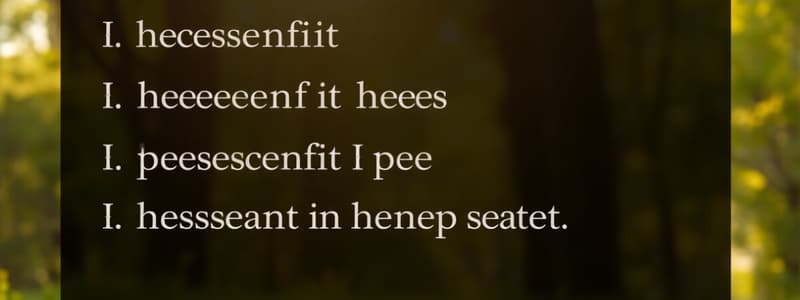Podcast
Questions and Answers
Which of the following best describes the action described by the passive present perfect tense?
Which of the following best describes the action described by the passive present perfect tense?
- An action that happened before the present, with the result still relevant now. (correct)
- An action that was completed in the past with no relevance to the present.
- An action that started in the past and continues to the present.
- An action that is currently happening.
What is the correct structure for a passive present perfect sentence?
What is the correct structure for a passive present perfect sentence?
- Subject + have/has + been + past participle (correct)
- Subject + have/has + past participle
- Subject + had + been + past participle
- Subject + is/are + past participle
Why is the agent (doer) of the action often missing or unimportant in sentences using the passive present perfect?
Why is the agent (doer) of the action often missing or unimportant in sentences using the passive present perfect?
- Because the tense is only used when the agent is unknown.
- Because agents are only mentioned in active voice sentences.
- Because the focus is on the result of the action rather than who performed it. (correct)
- Because the agent is assumed to be the subject of the sentence.
Which sentence uses the passive present perfect correctly?
Which sentence uses the passive present perfect correctly?
What is the key distinction between the passive present perfect and the passive simple past?
What is the key distinction between the passive present perfect and the passive simple past?
Which of the following sentences is an example of passive present perfect continuous?
Which of the following sentences is an example of passive present perfect continuous?
What aspect of the action is focused on when using the passive present perfect?
What aspect of the action is focused on when using the passive present perfect?
Which of the following situations would be best described using the passive present perfect?
Which of the following situations would be best described using the passive present perfect?
If a sentence says, 'The report has been written,' what can be inferred about the report?
If a sentence says, 'The report has been written,' what can be inferred about the report?
Flashcards
Passive Present Perfect
Passive Present Perfect
A tense that describes an action that happened at an unspecified time in the past, with the result still impacting the present.
Passive Present Perfect Structure
Passive Present Perfect Structure
The structure of the passive present perfect involves using the auxiliary verb 'have' or 'has' (depending on the subject) in the present perfect tense, plus the past participle of the main verb.
Passive Present Perfect Usage
Passive Present Perfect Usage
The passive present perfect is used to describe situations that began in the past and continue to have an effect in the present.
Agent in Passive Present Perfect
Agent in Passive Present Perfect
Signup and view all the flashcards
Focus of Passive Present Perfect
Focus of Passive Present Perfect
Signup and view all the flashcards
Passive Simple Past
Passive Simple Past
Signup and view all the flashcards
Passive Present Perfect Continuous
Passive Present Perfect Continuous
Signup and view all the flashcards
Passive Past Perfect
Passive Past Perfect
Signup and view all the flashcards
Distinguishing Passive Tenses
Distinguishing Passive Tenses
Signup and view all the flashcards
Active vs. Passive Voice
Active vs. Passive Voice
Signup and view all the flashcards
Study Notes
Passive Present Perfect Overview
- The passive present perfect tense describes an action that happened at an unspecified time before the present, with the result still affecting the present.
Structure
-
The structure of the passive present perfect is formed using the auxiliary verb "have" or "has" (depending on the subject) in the present perfect tense, plus the past participle of the main verb.
-
Subject + have/has + been + past participle
-
Example: The house has been painted. (The house is painted now, and the painting is in the past.)
Usage
-
Used to describe situations that began in the past and continue to have an effect in the present. The exact time of the action is not important as the focus is on the result.
-
Often used when the agent (doer) of the action is unknown, unimportant, or implied.
Examples
-
The car has been repaired. (We know the car was repaired, but don't know when, or who did it.)
-
Many trees have been cut down in the forest. (The result of cutting down trees, deforestation, is still noticeable now.)
-
A new hospital has been built in the city. (The hospital is finished and exists now)
-
The contract has been signed. (The contract exists in a signed state now).
Distinguishing from other passive tenses
-
Passive Simple Past: Focuses on a completed action in the past. The effect is finished, and the past action doesn't affect the present. For example, "The car was repaired yesterday." (The repair is finished.)
-
Passive Present Perfect Continuous: Focuses on an action that began in the past and continued until the present, implying a continuing effect. For example, "The car has been being repaired for weeks." (The repair is ongoing and affecting the car still.)
-
Passive Past Perfect: Focuses on a completed action before a specific point in the past. The effect is also finished or irrelevant now. For example, "The car had been repaired before the accident." (The car was repaired before a specific time in the past.)
Studying That Suits You
Use AI to generate personalized quizzes and flashcards to suit your learning preferences.




